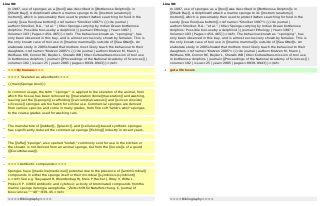
In slang, a troll is a person who posts deliberately offensive or provocative messages online or who performs similar behaviors in real life. The methods and motivations of trolls can range from benign to sadistic. These messages can be inflammatory, insincere, digressive, extraneous, or off-topic, and may have the intent of provoking others into displaying emotional responses, or manipulating others' perception, thus acting as a bully or a provocateur. The behavior is typically for the troll's amusement, or to achieve a specific result such as disrupting a rival's online activities or purposefully causing confusion or harm to other people. Trolling behaviors involve tactical aggression to incite emotional responses, which can adversely affect the target's well-being.

A troll is a being in Nordic folklore, including Norse mythology. In Old Norse sources, beings described as trolls dwell in isolated areas of rocks, mountains, or caves, live together in small family units, and are rarely helpful to human beings.

Bremanger is a municipality in Vestland county, Norway. The village of Svelgen is the administrative centre of the municipality. Other villages include Bremanger, Berle, Davik, Isane, Kalvåg, Svelgen, Rugsund, and Ålfoten. Bremanger is the only municipality in Vestland, which is located in two districts. The northern and eastern parts comprising the villages of Oldeide, Berle, Rugsund, Davik, Isane, and Ålfoten is located in the Nordfjord region, while the villages of Bremanger, Kalvåg, Svelgen, Sørgulen, and Botnane are located in the Sunnfjord region. Politically, the municipality works with the Nordfjord region in the council of Nordfjord municipalities.
Nordic folklore is the folklore of Denmark, Norway, Sweden, Iceland and the Faroe Islands. It has common roots with, and has been under mutual influence with, folklore in England, Germany, the Low Countries, the Baltic countries, Finland and Sápmi. Folklore is a concept encompassing expressive traditions of a particular culture or group. The peoples of Scandinavia are heterogenous, as are the oral genres and material culture that has been common in their lands. However, there are some commonalities across Scandinavian folkloric traditions, among them a common ground in elements from Norse mythology as well as Christian conceptions of the world.
Trolls are fictional characters in J. R. R. Tolkien's Middle-earth, and feature in films and games adapted from his novels. They are portrayed as monstrously large humanoids of great strength and poor intellect. In The Hobbit, like the dwarf Alviss of Norse mythology, they must be below ground before dawn or turn to stone, whereas in The Lord of the Rings they are able to face daylight.

Peer Gynt is a five-act play in verse written in 1867 by the Norwegian dramatist Henrik Ibsen. It is one of Ibsen's best known and most widely performed plays.
"In the Hall of the Mountain King" is a piece of orchestral music composed by Edvard Grieg in 1875 as incidental music for the sixth scene of act 2 in Henrik Ibsen's 1867 play Peer Gynt. It was originally part of Opus 23 but was later extracted as the final piece of Peer Gynt, Suite No. 1, Op. 46. Its easily recognizable theme has helped it attain iconic status in popular culture, where it has been arranged by many artists.

"Three Billy Goats Gruff" is a Norwegian fairy tale collected by Peter Christen Asbjørnsen and Jørgen Moe in their Norske Folkeeventyr, first published between 1841 and 1844. It has an Aarne-Thompson type of 122E. The first version of the story in English appeared in George Webbe Dasent's translation of some of the Norske Folkeeventyr, published as Popular Tales from the Norse in 1859. The heroes of the tale are three male goats who need to outsmart a ravenous troll to cross the bridge to their feeding ground.

Troll is a Norwegian research station located at Jutulsessen, 235 kilometres (146 mi) from the coast in the eastern part of Princess Martha Coast in Queen Maud Land, Antarctica. It is Norway's only all-year research station in Antarctica, and is supplemented by the summer-only station Tor. Troll is operated by the Norwegian Polar Institute and also features facilities for the Norwegian Meteorological Institute and the Norwegian Institute for Air Research.

The Little Troll Prince is a 1987 animated Christmas television special produced by Hanna-Barbera. Backed by the International Lutheran Laymen's League, it has strong Christian themes of unconditional love, self-sacrifice, and redemption, with a substantial Protestant influence. The story was a written as a parable script for the Christmas special. The special aired in syndication on US broadcast TV.

Queen Maud Land is a roughly 2.7-million-square-kilometre (1.0-million-square-mile) region of Antarctica claimed by Norway as a dependent territory. It borders the claimed British Antarctic Territory 20° west and the Australian Antarctic Territory 45° east. In addition, a small unclaimed area from 1939 was annexed in June 2015. Positioned in East Antarctica, it makes out about one-fifth of the continent, and is named after the Norwegian Queen Maud (1869–1938).

Jutulsessen is a nunatak in the Gjelsvik Mountains in Queen Maud Land, Antarctica. It is located in Princess Martha Coast, 235 kilometers (146 mi) from the King Haakon VII Sea. Jutulsessen is the site of the Norwegian research station Troll and the affiliated Troll Satellite Station, which has two radomes on top of the mountain. Troll Airfield is located in the vicinity.

Trollhunter is a 2010 Norwegian dark fantasy film, made as a "found footage" mockumentary. Written and directed by André Øvredal, and featuring a mixed cast of relatively unknown actors and well-known Norwegian comedians, including Otto Jespersen, Trollhunter received positive reviews from Norwegian critics. It opened on 10 June 2011 in the United States to a mostly positive critical reception.

Troll Satellite Station, commonly abbreviated TrollSat, is a satellite ground station located at Troll in Queen Maud Land, Antarctica. The earth station is owned by Kongsberg Satellite Services (KSAT), a joint venture between the Kongsberg Group and the Norwegian Space Center. The radomes are located on top of Jutulsessen, a nunatak area next to the research station at Troll. The research station is operated by the Norwegian Polar Institute, which also maintains the earth station. TrollSat started operations on 1 March 2007 and was officially opened on 20 January 2008.

Trolls is a 2016 American animated jukebox musical comedy film produced by DreamWorks Animation and distributed by 20th Century Fox, based on the Good Luck Trolls dolls created by Thomas Dam. The film was directed by Mike Mitchell from a screenplay by Jonathan Aibel and Glenn Berger, based on a story by Erica Rivinoja. It stars the voices of Anna Kendrick, Justin Timberlake, Zooey Deschanel, Russell Brand, James Corden and Gwen Stefani. The film follows two trolls named Poppy (Kendrick) and Branch (Timberlake) who go on a quest to save their village from destruction by the Bergens, giant creatures who eat Trolls to be happy.

Frozen Ever After and Anna and Elsa's Frozen Journey are musical reversing Shoot the Chute dark rides at Epcot, Hong Kong Disneyland, Tokyo DisneySea, and Walt Disney Studios Park. The attractions feature scenes inspired by Disney's 2013 animated film Frozen as well as the 2015 animated short Frozen Fever. Its first installation in Epcot opened on June 21, 2016, using the ride vehicles and track layout of the former Maelstrom attraction. A version of the attraction opened at Hong Kong Disneyland on November 20, 2023, as part of The Walt Disney Company's centennial celebration, and Tokyo DisneySea on June 6, 2024, with one more scheduled to open at Disney Adventure World in the spring of 2025.
Prince Wolf is a Danish fairy tale collected by Svend Grundtvig in his book Danske Folkeaeventyr. It is related to the international cycle of the Animal as Bridegroom or The Search for the Lost Husband. Tales with similar motifs and elements are found across Denmark and Scandinavia.

Hilda and the Mountain King, marketed as Hilda: The Mountain King, is a 2021 animated adventure fantasy film directed by Andy Coyle and written by Luke Pearson. It is based on the sixth edition of the Hilda graphic novel series of the same name by Pearson and is a continuation of the second-season finale of the Hilda animated series. The film features the voices of Bella Ramsey, Ameerah Falzon-Ojo, Oliver Nelson, Daisy Haggard, Rasmus Hardiker, John Hopkins and Lucy Montgomery.

Troll is a 2022 Norwegian epic monster film directed by Roar Uthaug. Starring Ine Marie Wilmann, Kim Falck, Mads Sjøgård Pettersen, and Gard B. Eidsvold, it follows a ragtag group of people who must come together to stop an ancient troll that was awakened in a Norwegian mountain and prevent it from wreaking havoc.















